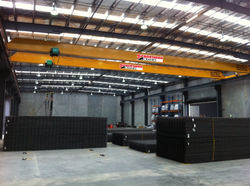Crane Manufacturers & Suppliers Melbourne | Gantry| Overhead|
Jib Cranes |Melbourne|Victoria
 |
|---|
 |
 |
SINGLE GIRDER CRANES
Lifting Capacity: 1~32t
Span: 7.5m~35m
Lifting Height: 6m,9m,12m,15m,18m
Working Class: A5,A6
Remarks: Span≥ 32m
CRANE SUPPLIERS & MANUFACTURERS IN MELBOURNE, VICTORIA
Northern Cranes design, manufacturer & supplier of gantry cranes, jib cranes, wire rope hoist, chain hoist and other material handling equipment to cities throughout Australia, including Victoria, Melbourne, New South Wales-Sydney, South Australia-Adelaide, Brisbane-Queensland, Western Australia-Perth and Tasmania
If you are require an overhead crane or bridge crane with up to 20 Tonnes capacity with a short to medium span, then a single girder crane is a cost effective option. Intended for low to medium duty cycles, these cranes are ideal for production and manufacturing shops that move moderate loads. Available in top or under running, with low headroom wire rope hoist.
The single girder overhead gantry ranges from 1,000kg to 32 tonnes capacity with duties ranging from M3 to M6.
The hoist unit is available in normal headroom and low headroom configuration. Single girder gantries come available with single or double hoists, pendant or radio control and inverter motor drives
At Northern Cranes we manufacture Overhead Cranes and Bridge Cranes that offer exceptional reliability and dependability at competitive prices.
When selecting an Overhead Crane it is important to first understand the needs of your system and select a product that will provide a reliable solution in your particular environment, that works with your facilities structural capabilities. Single Girder Top Running Overhead Cranes are designed to travel on top of a runway system that can be either supported by engineered columns or existing building columns. Our collaborative approach ensures that the Overhead Crane System you select exceeds your expectations for not only quality but reliability. We assess your facilities capabilities, evaluate the needs of the system, determine weight and span requirements, and recommend systems that are tailored to your specific needs.
Northern Cranes partners with industry leading suppliers to offer exceptional parts and components when designing and manufacturing Overhead Crane Systems. What that means is we provide our Customers with only the most innovative and technologically advanced components when designing and manufacturing a Crane System.
Our years of experience in the industry Overhead and Bridge Crane Manufacturing sets us apart from the competition and how we can increase productivity and safety at your facility!
Single girder cranes can be specified with dual speed operation just like other types of crane along with options for radio control and pendant control and advanced features.
When ordering a single girder overhead crane you will have the option of an electric Wire Rope Hoist or Chain Hoist. Most customers using the crane for larger capacities or more frequently choose Wire Rope as this is a more durable and cost effective solution in the long term. The hoist travels along the bottom flange of the crane beam to give full coverage of the cranes span.
SINGLE GIRDER VS. DOUBLE GIRDER BRIDGE CRANES
An overhead bridge crane can be configured in a single girder or double girder design. In simple terms, a bridge girder, or beam, is the support structure that allows the trolley and hoist to move from side-to-side along the bridge. The trolley is used to precisely position the hoist prior to raising or lowering a load.
To a degree, both single and double girder cranes are equal in strength and durability. The main difference between the two comes down to hook height, or how high above the ground your hoist can lift. A double girder crane can provide more hook height because the hoist is placed on top of the girders, instead of below them.
There are some instances where a double girder or single girder configuration may be the better option.
Single Girder – The bridge consists of one girder beam supported on each side by an end truck. The trolley and hoist are most commonly underhung—meaning they run on the bottom flange of the bridge. They also tend to be less expensive due to:
Only one girder is required to move the trolley
Reduction in freight expenses
Faster installation
Simpler hoist and trolley design
What Type of Crane Do I Need?
When you purchase hoist, parameters need to offer as followings:
1. Lifting capacity
2. Lifting height
3. Working class (how many hours the crane will work in one working day)
4. The Voltage, frequency
5. The beam model to match (I beam or box type beam)
6. Power supply system?
7. Hoist model (wire rope hoist or chain hoist, if chain hoist, manual type or electric type,manual motorized trolley)
8. Working environment(temperature, humidity, elevation)
When you purchase complete crane, parameters need to offer as followings:
1. What kind of crane? (overhead crane, gantry crane , suspension crane, lifting mechanism is hoist type or winch type)
2. What is the purpose of crane? or what you lift with crane?
3. Lifting capacity
4. Span (you can supply workshop layout or the workshop length and width)
5. Lifting height
6. Working conditions (how many hours the crane work in one day, how about weight you lift at one time? how long time only in one working period? how many the cycle times in one day?)
7. Working environment (temperature, humidity, elevation)
8. The Voltage, frequency
9. Wind speed (when need gantry crane)
10.Do you have some special functions requests? (Working area, intelligent functions etc.)
Think Long-Term
When you consider these questions, things can be a bit overwhelming, but it could make the difference between simply spending some money on an overhead lifting system and investing in a system to improve your operations, increase worker safety and efficiency, and improve product quality
Every project has a budget. In an attempt to control project costs, some customers consider inappropriate crane types that can be risky, often greatly reducing the effectiveness of the crane and, in the long run, wasting money. Starting with an honest evaluation of your lifting needs is of paramount importance in selecting a crane for your factory.


